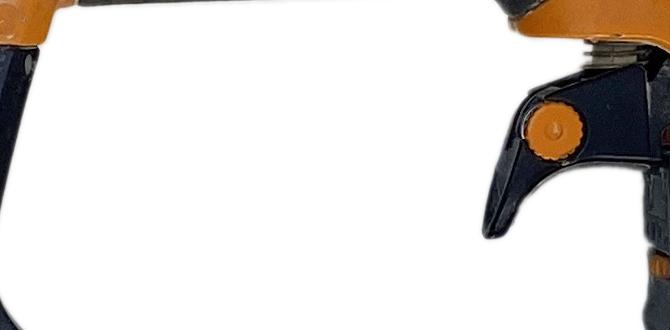Quick Summary: Navigating nail gun types can be confusing for beginners. This beginner-friendly nail gun comparison chart simplifies your choice by outlining common nailer types, their best uses, and key features, helping you pick the perfect tool for your DIY projects with confidence.
Hey there, DIY warriors and budding woodworkers! Jack Shaffer here, your friendly guide from Nailerguy. Ever stare at a wall of nail guns and feel a little overwhelmed? You’re not alone! Choosing the right nail gun can seem like picking a fight with a much smarter robot. But don’t sweat it, friend. We’ll break it all down so you can ditch the hammer, save your thumbs, and speed up your projects. This guide is all about making that decision easy. Get ready to discover which nailer is your new best friend for everything from framing a shed to adding that perfect baseboard trim!
Table of Contents
Your First Nail Gun: What You Need to Know
Picking out your first nail gun is a big step in any DIY journey. It’s like getting your first power drill – suddenly, projects you only dreamed of are within reach. Nail guns can make your work faster, more precise, and honestly, a lot more fun. But with so many options out there, knowing which one is right for you can be tough.
This guide is designed to clear the air. We’ll walk through the most common types of nail guns, what they’re best suited for, and what to look for. Think of this as your cheat sheet to nail gun success. By the end, you’ll feel confident choosing the tool that will help you tackle your projects with ease.
Different Strokes for Different Folks: Understanding Nail Gun Types
Nail guns aren’t one-size-fits-all. They are specialized tools, each designed for a particular job. Understanding these differences is the first step to making the right choice. Let’s dive into the most popular types you’ll encounter:
1. The Framing Nailer: For the Heavy Lifters
When you think of big construction jobs, like building a house frame or a deck, the framing nailer comes to mind. These are the powerhouses of the nail gun world. They use larger nails and are built to drive them deep into thick lumber. If your project involves building sturdy structures, this is your go-to.
- Best for: Framing walls, building decks, fences, and other rough construction.
- Nail Size: Larger nails, typically 2 to 3.5 inches long.
- Power Source: Usually pneumatic (air-powered), some gas-powered options exist.
- Pros: Incredible power, fast driving, ideal for structural work.
- Cons: Heavy, bulky, typically requires an air compressor, over-kill for smaller projects.
2. The Finish Nailer: For Clean, Professional Edges
This is the workhorse for many DIYers and trim carpenters. Finish nailers drive smaller, slimmer headless nails. These nails leave a small hole that’s easy to fill, making them perfect for attaching trim, molding, and other decorative woodworking. They offer a clean, professional look.
- Best for: Installing baseboards, crown molding, window and door casings, chair rails, and general trim work.
- Nail Size: Medium-sized nails, typically 1.5 to 2.5 inches long (14 or 16 gauge).
- Power Source: Can be pneumatic, electric (corded or cordless), or gas-powered.
- Pros: Versatile, leaves minimal, easy-to-fill holes, good balance of power and portability.
- Cons: Not strong enough for structural work, requires different nail sizes for different projects.
3. The Brad Nailer: For Delicate Details
Brad nailers are similar to finish nailers but use even thinner nails (often 18 gauge), which have very small heads. This means they leave almost invisible holes. They are fantastic for attaching delicate trim, small moldings, or anything where you want to minimize visible fasteners. They don’t have the holding power of a finish nailer, so they’re not for structural applications.
- Best for: Small trim, delicate woodworking projects, attaching thin materials, paneling, and crafts.
- Nail Size: Thin nails, typically 0.75 to 1.5 inches long (assume 18 gauge).
- Power Source: Commonly electric (corded or cordless), some pneumatic.
- Pros: Leaves very small, almost invisible holes, great for detail work, lightweight and easy to maneuver.
- Cons: Limited holding power, only suitable for light-duty tasks and small fasteners.
4. The Pin Nailer: For the Invisible Touch
The pin nailer is for the projects where you absolutely do not want to see a nail head at all. It drives headless, ultra-fine pins (often 23 gauge). These pins are so small they barely leave a mark, and they provide just enough hold to keep pieces in place while glue dries. They offer no structural support on their own.
- Best for: Attaching tiny trim, holding pieces of wood together while glue sets, detailed craft projects, and anywhere a completely hidden fastener is essential.
- Nail Size: Extremely fine pins, typically 0.5 to 1 inch long (23 gauge).
- Power Source: Usually electric (corded or cordless), some pneumatic.
- Pros: Completely invisible fastening, ideal for delicate, high-precision work, very lightweight.
- Cons: No holding power on its own, only for very light-duty tasks where glue is the primary fastener.
5. The Roofing Nailer: For Shingle Specialists
If your project involves covering a roof, this is the tool you need. Roofing nailers are specifically designed to drive large nails with wide heads, perfect for securing shingles without tearing them. They are heavy-duty and built for outdoor, tough conditions.
- Best for: Installing asphalt shingles, roll roofing, and other roofing materials.
- Nail Size: Large, wide-headed nails specifically for roofing (typically 0.75 to 1.75 inches).
- Power Source: Mostly pneumatic, with some gas models.
- Pros: Fast and efficient for large roofing jobs, robust construction for outdoor use.
- Cons: Highly specialized, not useful for other woodworking tasks, can be heavy.
6. The Siding Nailer: For Exterior Walls
Similar to roofing nailers in robustness, siding nailers are designed to install various types of siding, like vinyl, wood, or fiber cement. They drive nails that are long enough to penetrate the siding and into the wall studs, ensuring a secure and weather-tight fit. Some can also be used for fencing.
- Best for: Installing exterior siding materials (vinyl, wood, fiber cement), some fencing applications.
- Nail Size: Nails typically 1.5 to 2.5 inches long, often with collation angles designed for siding installation.
- Power Source: Often pneumatic, some cordless electric models available.
- Pros: Efficient for siding installation, drives nails to the correct depth for secure fastening.
- Cons: Specialized tool, limited use outside of siding projects.
Nail Gun Comparison Chart for Beginners
To make things even clearer, here’s a quick glance at how these nailer types stack up against each other. This chart is your go-to reference when you’re trying to decide.
| Nail Gun Type | Primary Use | Typical Nail Gauge | Typical Nail Length | Power Source Options | Best for Beginners? | Key Feature |
|---|---|---|---|---|---|---|
| Framing Nailer | Structural framing, deck building | Various (e.g., 10-12 gauge) | 2 – 3.5 inches | Pneumatic, Gas | No (too powerful/specialized for most beginner projects) | High power for driving large nails into thick wood. |
| Finish Nailer | Trim, molding, baseboards | 14 or 16 gauge | 1.5 – 2.5 inches | Pneumatic, Electric (Corded/Cordless), Gas | Yes (very versatile for home improvement) | Drives medium nails with minimal, easy-to-fill holes. |
| Brad Nailer | Detail trim, small crafts | 18 gauge | 0.75 – 1.5 inches | Pneumatic, Electric (Corded/Cordless) | Yes (great for precision and small jobs) | Drives thin nails, leaving very small, almost invisible holes. |
| Pin Nailer | Invisible fastening, delicate crafts | 23 gauge | 0.5 – 1 inch | Pneumatic, Electric (Corded/Cordless) | Yes (for very specific, delicate tasks) | Drives headless pins for a completely unnoticeable finish. |
| Roofing Nailer | Installing shingles | N/A (specialized roofing nails) | 0.75 – 1.75 inches | Pneumatic, Gas | No (highly specialized) | Designed to quickly install roofing materials. |
| Siding Nailer | Installing exterior siding | Various (e.g., 15-16 gauge) | 1.5 – 2.5 inches | Pneumatic, Electric (Cordless) | No (specialized for exterior work) | Drives nails into siding and sheathing securely. |
Powering Your Nailer: The Options
Beyond the type of nailer, how it’s powered is a crucial decision. Each power source has its own set of pros and cons that can impact your experience, especially as a beginner.
1. Pneumatic (Air-Powered) Nailers
These are the classic nail guns. They rely on compressed air from an air compressor to drive nails. They are known for their power and durability.
- Pros: Powerful, lightweight (the tool itself), generally less expensive initial tool cost, very reliable.
- Cons: Requires an air compressor, air hose, and often an air filter/regulator. The compressor can be loud and takes up space. You need to be mindful of air pressure.
- For Beginners: Good if you already have a compressor or plan on doing a lot of projects where one is beneficial. The hose can be a tripping hazard, so extra care is needed.
2. Electric Nailers (Corded & Cordless)
Electric nailers have become incredibly popular due to their convenience. They come in two main types:
- Corded Electric Nailers: You plug them directly into a wall outlet.
- Pros: Unlimited power as long as you have an outlet, usually more affordable than cordless models.
- Cons: Limited by the length of the power cord, can be a tripping hazard, less portable.
- Cordless Electric Nailers (Battery-Powered): These use rechargeable batteries, offering the ultimate in portability. Many use a small, internal air-drive system.
- Pros: Excellent portability, no hoses or compressors, easy to set up and use anywhere, quieter than pneumatic.
- Cons: Can be more expensive upfront, battery life is a consideration, tool might be slightly heavier due to the battery.
- For Beginners: Cordless electric nailers are often the top recommendation for beginners due to their ease of use and portability. No fuss with compressors!
3. Gas-Powered Nailers
These nailers use a small fuel cell (like a propane cartridge) and a battery for ignition. They are almost always cordless and very powerful, often used for framing or post-nailing.
- Pros: Very portable, powerful, no air compressor needed.
- Cons: Fuel cells are an ongoing cost, can have a distinct smell from the exhaust, sometimes requires specific maintenance.
- For Beginners: Generally not the first choice for beginners due to the ongoing fuel cost and slightly more complex operation compared to battery-electric models.
Key Features to Look For: Beyond Type and Power
Once you’ve narrowed down the type and power for your needs, a few specific features can make a big difference in your day-to-day use of a nail gun:
- Depth Adjustment: This allows you to control how deep the nail is driven. Essential for not over-driving nails (leaving them sticking out) or driving them too deep (damaging the wood surface). Look for an easy-to-use dial or lever.
- Nail Jam Clearing: A quick-release or tool-free mechanism to clear jammed nails is a lifesaver. Nobody wants to be fumbling with tools to fix a jam in the middle of a project.
- Sequential vs. Contact Actuation:
- Sequential (or Single Fire): You must pull the trigger and press the nose of the gun against the wood for each nail. This is the safest mode and best for precision.
- Contact (or Bump Fire): You can hold the trigger down and “bump” the nose against the wood to fire nails rapidly. This is faster but less precise and requires extra caution. Many tools offer a switch to toggle between modes.
- No-Mar Pad: A rubber or plastic tip on the nose of the nailer prevents it from marring or denting soft woods while you’re firing nails.
- Adjustable Exhaust: For pneumatic nailers, an exhaust port that can be rotated allows you to direct air away from your face and line of sight.
- Weight and Ergonomics: If you’ll be using the nailer for extended periods or overhead, a lighter tool with a comfortable grip makes a huge difference.
Choosing Your First Nail Gun: A Beginner’s Roadmap
So, how do you put all this information together to pick your first nailer? Let’s simplify it.
- Assess Your Typical Projects:
- Mostly interior trim, baseboards, crown molding? A Finish Nailer (16 gauge) or a Brad Nailer (18 gauge) is likely your best bet. For small, delicate trim, the Brad Nailer is excellent. If you anticipate doing more general trim, the 16-gauge Finish Nailer offers more versatility.
- Building small rustic furniture, some light framing, or repairs? A Cordless Finish Nailer might still work, but if you’re doing any serious structural work, you might consider a Framing Nailer, though it’s a bigger investment and requires more safety learning. For most beginners, a good cordless finish nailer is a fantastic starting point.
- Crafts or very delicate woodworking where you need zero visible dots? A Pin Nailer is your specialized tool for this.
- Consider Your Existing Tools:
- Do you already own a good air compressor? A pneumatic nailer could be a cost-effective option.
- Are you starting from scratch and want maximum convenience? Go for a cordless electric nailer. This is often the easiest entry point.
- Budget:
- Entry-level pneumatic nailers can be inexpensive, but factor in the cost of a compressor, hose, and fittings. A decent compressor can cost as much or more than the nailer itself.
- Cordless electric nailers have a higher upfront cost for the tool and battery, but you save on compressor expenses and hoses. Look for starter kits that include a battery and charger.
- Start with Versatility:
If you’re truly unsure and want a tool that can handle a wide range of common DIY tasks, a cordless 16-gauge finish nailer is often the most recommended starting point for beginners. It’s powerful enough for most trim jobs, versatile, and easy to use.
Safety First! Always Use Your Nail Gun Responsibly
Nail guns are powerful tools, and responsible use is paramount. Always prioritize safety to avoid injury. A good resource for tool safety is the <a href="https://www.osha.gov/sites/default/files/publications/ni_nail_gun_poster.pdf" target="_


